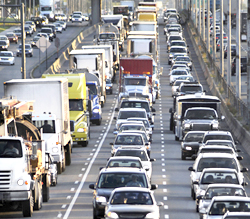Last Friday, after three years in the making, the California Air Resources Board unanimously approved automobile standards known as the California Advanced Clean Cars program. This emissions-control program will increase the number of low-pollution vehicles available to consumers starting in 2017, with a goal to have 1.4 million zero-emission cars on the road by 2025. These vehicles include plug-in hybrids, electric battery-powered cars, and hydrogen fuel cell cars. By 2025 one in seven new cars sold in the state must emit little or no pollution. Half a million of these cars are expected to be fuel cell or electric powered. The clean car rules also set the goal that by 2050 87% of vehicles must be fueled by clean technologies.
The Advanced Clean Cars program combines the control of smog-causing pollutants and greenhouse gas emissions into a single coordinated package of requirements for model years 2017 through 2025. Starting with model year 2015, automakers will have to meet tougher standards for smog-forming emissions and in 2017, greater limits on pollutants that contribute to global warming. By 2025, the standards are designed to reduce the average smog-forming emissions of new cars and light trucks by 75% compared with those sold today.
The greenhouse gas limits, which would be the same as the federal government has proposed for vehicles nationally, should cut those auto emissions by a third more in 2025 than required under current standards. To meet the new limits, the board staff anticipates the auto industry will make greater use of advanced hybrid technology, stronger and lighter materials and improved emission control equipment.
If oil companies don't reach an agreement with the state to voluntarily install alternative fueling stations, such as for hydrogen fuel cells, the new rules will also require them to do so when a certain number of cars using that fuel is reached. The outlets could be placed at an existing gasoline station or a free-standing site.
The California clean car rules also address emission standards for gasoline and diesel-powered vehicles by extending limits on greenhouse gas emissions and smog forming pollutants. Again, by 2025 all new vehicles must emit 34% fewer global warming gases and 75% fewer smog forming emissions. California has over 26 million cars and the top five smoggiest metropolitan areas in the country.
The California Air Resources board estimates that the initial increase in cost will be offset by an average of $6,000 worth of fuel savings over a vehicle’s lifetime. (Think Progress, 1/30/2012, LA Times, 1/28/2012)
(More Information)


No comments:
Post a Comment